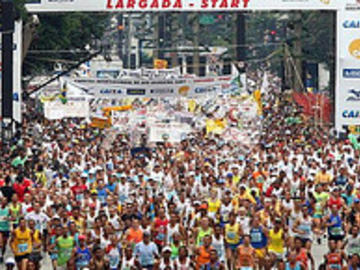Picture
More information on Sao Silvestre International Race

Description: Sao Silvestre International Race
Pedestrian Proof named "International Race of São Silvestre", created by journalist Casper Libero, is held on December 31, in São Paulo, a distance of 15 km, with the participation of people of both sexes. The International Race of São Silvestre is sponsored and owned by Casper Libero Foundation and sponsored by Gazeta Esportiva.Net. The Globo Television Network Foundation is a partner of Casper Libero in the organization and delivery of proof. History In the 1920s, Brazil was clearly the passage of an agricultural country dominated by the elite and the broad development of urban centers. Cities and especially the media, housed a population that was experiencing a pace of life that was distinguished from deep rural areas. The public sphere became increasingly agitated by events that caught the attention of thousands of people.
In 1924, journalist Casper Libero returned from a trip to France marvel at a night race in which competitors carried torches along the route. Excited about the event and passion for the game, he decided to promote a race to be held at the turn of that year. On December 31, 1924, only forty-eight of sixty competitors attended the first edition of the São Silvestre Race. Over time, competition has survived the most varied setbacks that threatened its existence.
The Constitutional Revolution of 1932 and the advent of World War II were not enough to prevent the annual event and continue to add new competitors. Over time, some foreigners just received invitations to compete in the competition. The Italian Hector Blasi, rooted in the country, won the 1925 and 1927 editions. In its first incarnations, to St. Sylvester was performed in 23 minutes and crossed a path of 8.8 km. Participants did not receive any type of special diet and were strictly forbidden to drink water during the race. Lacking a support specialist, the runners used the same training shoes for the race and wore sweat that accumulated in the fibers. Improvisation and inexperience acted as a rule. To the extent that competition has grown, the Saint Sylvester caught the attention of professional athletes worldwide.
Currently, a professional runner prepares a diet rich in carbohydrates and supplements times before the race. In addition, hydration throughout the race became a great ally to support the highs and wear naturally produced by the competition. Special shoes and electronics monitor the performance of athletes in 15 km competition. In 1975, the UN declared that as the International Year of Women. Mindful of the impact of this announcement, the test determined that a female form also part of the competition. The first few times it happened, men and women traveled together to the path only after they have their separate ratings. In 1989, the course was reversed, the competition was to be held in the afternoon and the race was separated by sex. Only in 1991, when the race began to be exactly 15,000 meters, was that the International Association of Athletics Federations included São Silvestre in the international calendar. Two years later, a juvenile version of the expanded public contest and won the name "St. Silvestrinha." Even today the Kenyan Paul Tergat is the record holder for time and one of the biggest winners of the competition with four wins.
Photo by: Renato Luiz Ferreira
More Photos of Picture

